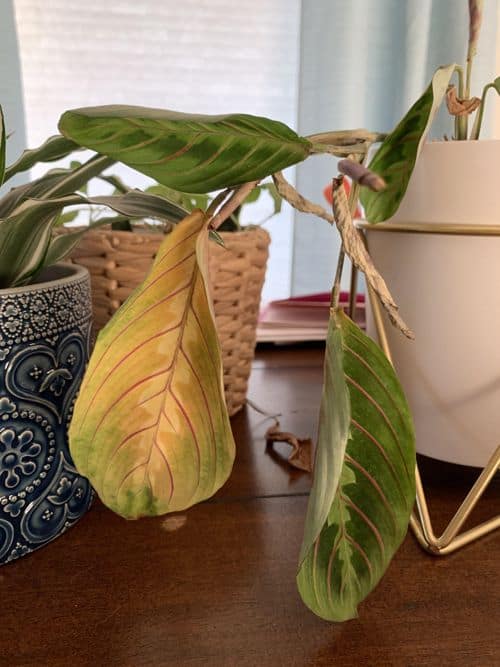Have you ever wondered about how to revive a prayer plant?
Perhaps your once-thriving prayer plant (Maranta leuconeura) is suddenly droopy and worse, it is starting to die.
Many plant parents face the challenge of reviving a struggling prayer plant, and the good news is that with the right care and attention, you can nurse it back to health.
In this comprehensive guide, we’ll cover the signs of a prayer plant dying, whether it’s wilting leaves, yellowing foliage, or lackluster growth. Find out how to revive it and keep it healthy and beautiful once again!

Common Signs Of A Prayer Plant Dying
Prayer plants (Maranta leuconeura) are known for their striking foliage and vibrant colors. However, like any plant, they can experience stress and decline if their needs are not met. Recognizing the signs of a dying prayer plant is essential for timely intervention and revival:
1. Yellowing Leaves
This is a primary indicator of stress. While some yellowing of older leaves is normal, widespread or rapid yellowing can signal a problem. This issue can result from overwatering, underwatering, nutrient deficiencies, or environmental stress.
2. Wilting
When prayer plant leaves begin to droop and lose their turgidity, it indicates a lack of moisture or other stress factors. Wilting can be caused by both overwatering (leading to root rot) and underwatering (resulting in water stress).
3. Crispy Leaf Edges
Brown or crispy edges on the leaves suggest low humidity or inconsistent watering. Inadequate humidity can cause leaf edges to dry out, as can allowing the soil to dry too much between waterings.
4. Leggy Growth
Generally, leggy growth is characterized by long, stretched-out stems with sparse foliage. This occurs when the plant doesn’t receive enough light, particularly bright, indirect light which it prefers.
5. Leaf Drop
Excessive leaf drop where healthy leaves fall for no apparent reason indicates stress or an unhealthy plant. This can be due to various factors, including inconsistent watering, temperature fluctuations, or pest infestations.
6. Mold or Mildew
Presence of mold or mildew on the soil surface or lower leaves suggests poor air circulation and overwatering. Overly moist soil combined with inadequate ventilation can create a favorable environment for mold and mildew growth.
7. Root Rot
Brown, mushy, or foul-smelling roots are indicative of root rot, a severe condition. Root rot is usually caused by overwatering and poor drainage, which leads to oxygen-deprived roots.
8. Stunted Growth:
A prayer plant that has stopped growing or exhibits very slow growth may lack essential nutrients or adequate light. Nutrient deficiencies, compacted soil, or insufficient lighting can hinder growth.
Understanding these signs and their potential causes is the first step in diagnosing and addressing issues with your prayer plant. Timely intervention and proper care can often help revive a struggling prayer plant and restore its health and vitality.
How To Revive A Dying Prayer Plant
Reviving a struggling prayer plant (Maranta leuconeura) can be done by addressing the underlying issues that have caused it to decline. Here’s a step-by-step guide on how to revive your prayer plant:
1. Assess the Plant
Begin by carefully examining your prayer plant to identify the specific problems it’s facing. Look for yellowing leaves, browning edges, pests, and signs of disease. Understanding the issues will help you take appropriate actions.
2. Reevaluate Watering
Ensure you are providing the right amount of water. Prayer plants like consistently moist but not waterlogged soil. Adjust your watering schedule based on the moisture needs of your plant. Always check the top inch of soil, and water when it feels slightly dry.
3. Repot if Necessary
If your prayer plant is root-bound or if the potting soil has become compacted and not retaining moisture properly, consider repotting it into a slightly larger container with fresh, well-draining potting mix. Repotting can provide more space for healthy root growth and better water retention.
4. Prune Damaged Leaves
Trim away any yellow or brown leaves. This not only improves the plant’s appearance but also directs energy toward healthy growth.
Read more: Common Reasons And Tips To Prune Prayer Plant
5. Provide Humidity
Prayer plants thrive in high humidity environments. If your home is dry, consider increasing humidity levels around the plant. You can do this by using a humidifier, placing a tray filled with water and pebbles near the plant, or misting the plant regularly.
6. Fertilize Appropriately
Use a balanced, water-soluble fertilizer diluted to half strength during the growing season (spring and summer). Avoid over-fertilizing, as this can lead to nutrient imbalances.
7. Adjust Lighting
Ensure your prayer plant is receiving the right amount of indirect or filtered sunlight. Avoid direct sunlight, as it can scorch the leaves. If your plant is in a low-light location, consider providing a bit more light, as insufficient light can lead to weak growth.
8. Check for Pests
Examine the plant for pests like spider mites, mealybugs, or aphids. If you find any, treat the plant with an appropriate insecticidal soap or neem oil solution. Isolate the plant to prevent the pests from spreading.
9. Monitor Temperature
Keep your prayer plant in a stable temperature range between 65°F to 75°F (18°C to 24°C) and avoid exposing it to drafts or temperature extremes.
10. Be Patient
Reviving a plant takes time. Even after you’ve addressed the issues, it may take several weeks or even months for your prayer plant to recover fully. Be patient and continue to provide proper care.
Summary
Remember that each prayer plant can have slightly different care requirements, so pay attention to how your specific plant responds to your care efforts. With consistent care and attention, there’s a good chance your prayer plant will recover and thrive once again.